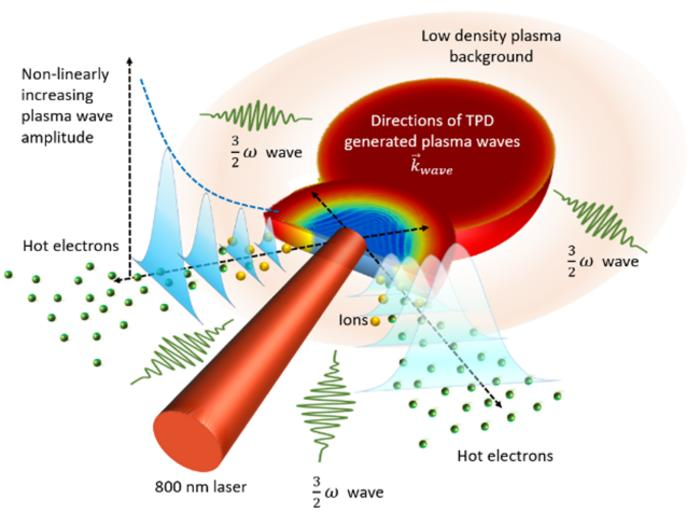Reviewed by Lexie CornerMar 14 2024
Subatomic particles, such as electrons, are accelerated to speeds nearing the speed of light in massive particle accelerators as they approach a target surface.
 Laser beam incident on the structured droplet sets up plasma waves (blue pulses) that accelerate electrons (green solid spheres) to megaelectronvolt energies. Image Credit: Adapted from Mondal, Angana, Ratul Sabui, Sheroy Tata, R. M. G. M. Trines, S. V. Rahul, Feiyu Li, Soubhik Sarkar, et al. Communications Physics.
Laser beam incident on the structured droplet sets up plasma waves (blue pulses) that accelerate electrons (green solid spheres) to megaelectronvolt energies. Image Credit: Adapted from Mondal, Angana, Ratul Sabui, Sheroy Tata, R. M. G. M. Trines, S. V. Rahul, Feiyu Li, Soubhik Sarkar, et al. Communications Physics.
Scientists can learn more about the basic characteristics of matter through the unique interactions created when accelerated subatomic particles collide.
Traditionally, laser-based particle accelerators are housed in large national facilities and require costly lasers (in the range of 1-20 million USD). This intricate setup can drive electrons to energies measured in megaelectron volts (MeV). Can similar particle acceleration schemes be designed with a less complex laser that costs a fraction of what they do now?
Researchers at the Tata Institute of Fundamental Research, Hyderabad (TIFRH) have made a significant breakthrough in their work by devising a sophisticated method for producing electrons at MeV (106 eV) temperature with only a fraction (100 times smaller) of the laser intensity that was previously believed to be required. The technique uses two laser pulses to accelerate electrons to MeV energies: the first to create a tiny, controlled explosion in a microdroplet.
Even more exciting is that they accomplished this using a laser 100 times smaller than previously believed to be required, which increases accessibility and versatility for further research. Due to the discovery’s capacity to generate high-energy electron beams for various applications, including imaging, tomography, microscopy, and non-destructive testing, the implications for material science and biological sciences could be profound.
The setup devised by TIFRH researchers utilizes a millijoule class laser, operating at a frequency of 1000 pulses per second with ultrashort 25 fs pulses. It is employed to dynamically sculpt micro-droplets of 15 µm diameter. This dynamic target-shaping process involves two laser pulses operating simultaneously. The initial pulse sculpts a concave surface in the liquid drop, while the subsequent pulse induces electrostatic plasma waves, accelerating electrons to MeV energies.
The oscillations in plasma, known as electrostatic waves, are similar to the mechanical disruptions caused by passing a stone through a water pond. In this instance, the laser disturbs the electron sea and produces an “electron tsunami” that breaks to release high-energy electrons, resembling a wave slamming against the coast.
The process produces two electron beams, each with a different temperature component of 200 keV and 1 MeV. This invention, which uses a tabletop laser to generate directed electron beams beyond 4 MeV, is revolutionary for time-resolved, microscopic research in various scientific domains.
Journal Reference:
Mondal, A., et al. (2024) Shaped liquid drops generate MeV temperature electron beams with millijoule class laser. Communications Physics. doi.org/10.1038/s42005-024-01550-8